On September 3, 1949, a U.S. Air Force WB-29 aircraft of the 375th Weather Reconnaissance Squadron passed near Russia’s Kamchatka Peninsula. Paper filters fitted to the plane’s specially designed air scoop picked up airborne dust particles during the flight. Immediately after the WB-29 landed at its home base in Alaska, technicians used long tongs to remove the paper filters, placing them in leaded containers that were then rushed to a laboratory for detailed analysis. The tests showed the filters were thoroughly speckled with the radioactive debris of a recent atomic explosion.
More than a year had passed since the United States had last detonated an atomic bomb, but this evidence was fresh, only a few days old. There was only one explanation: the U.S. atomic monopoly was over.
In those early years of the nuclear age, figuring out Soviet nuclear capabilities was a fairly uncomplicated, if indirect, proposition. The United States collected air samples of radioactive debris from test shots whenever possible, gathered intelligence through spies, analyzed whatever other information sources were available, and then made deductions and speculations from there. While the specific details of the Russian atomic arsenal may have been debatable, the existence of the weapons was never in doubt.
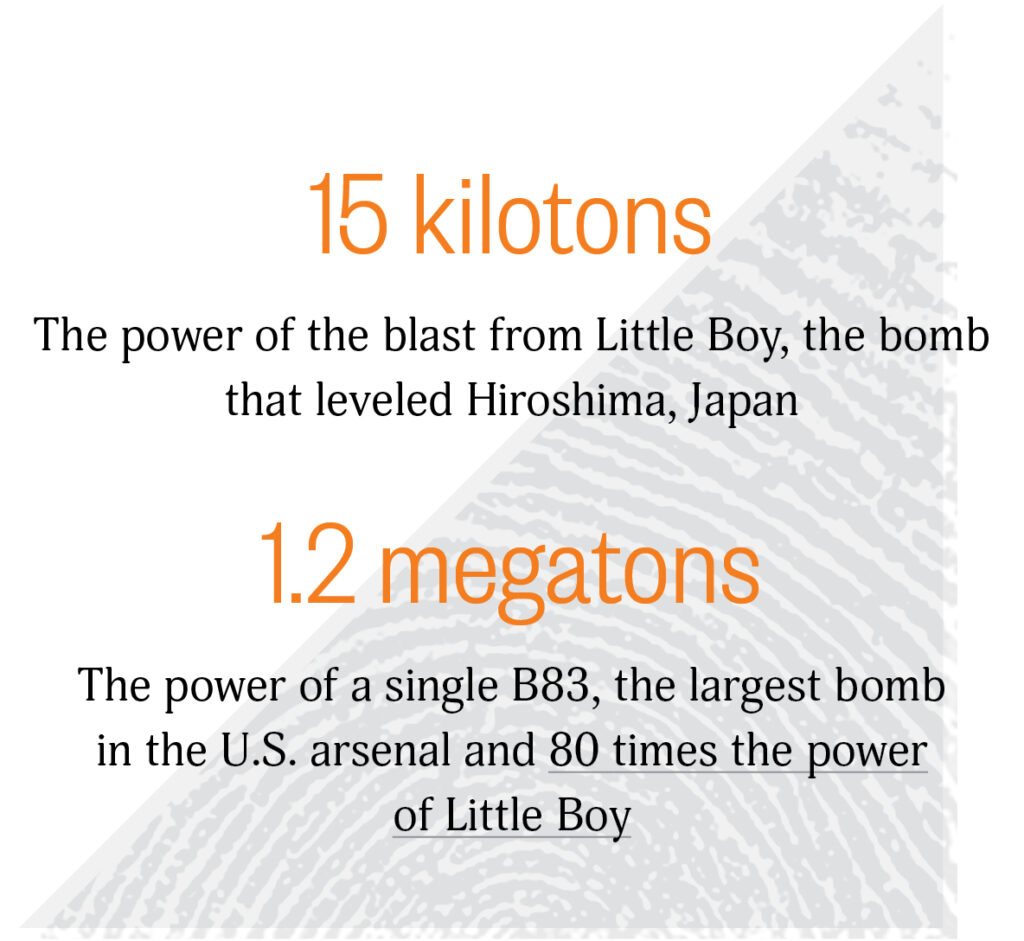
But the relative simplicity of a bipolar nuclear world wouldn’t last. Soon other nations, friendly and otherwise, got the bomb. Civilian nuclear-energy technology spread around the world and inevitably so did the potential for weapons proliferation. In 1970 almost 50 United Nations member states signed the Nuclear Nonproliferation Treaty (NPT), committing themselves to never developing nukes; but not all countries joined, and some that did attempted to secretly acquire the weapons anyway. Suddenly, it was no longer enough to simply sniff out a Russian or Chinese atomic test. Now it was also necessary to monitor and keep in check the military ambitions of nuclear have-not states while allowing them to use nuclear material for peaceful purposes, such as in reactors for power and as isotopes in medical research and treatment. How then to tell the cheaters from the good guys? And how to detect and prevent crooks and terrorists from stealing, smuggling, and selling uranium and plutonium to unstable regimes?
Answering these questions is the task of a dedicated group of individuals all over the world, some of whom work under the aegis of the United Nations, others for individual governments, and the rest at independent laboratories and universities. All have the same goal: to keep nuclear material out of illicit hands and thus reduce the dangers of nuclear terrorism and nuclear war. It’s an ongoing quest that combines diplomacy, down-and-dirty politics, detective work, and hard science.
Under the terms of the NPT the United States, Soviet Union, and United Kingdom, three of the five nuclear powers at the time (France and China were the others), pledged to share peaceful nuclear technology with other nations while preventing the transfer of military nuclear capabilities; they also pledged to undertake good-faith efforts toward nuclear disarmament. Meanwhile, the nuclear have-nots agreed they would not develop nuclear weapons on their own or accept weapons technology from anyone else. The International Atomic Energy Agency (IAEA), formed by the United Nations in 1957 to promote the peaceful use of atomic energy, was given chief responsibility for verifying compliance and detecting any violations of the NPT.
These agreements were made with the best of intentions, but human nature and international politics being what they are, the results have been mixed. Although the NPT was extended indefinitely in 1995, the number of nuclear-weapons states has expanded to include India, Pakistan, Israel, and North Korea, while other nations, including Iran and Iraq, have done their best to join the nuclear club. As the 20th century dissolved into the 21st, the international threat of terrorism continued to grow, and with it the likelihood of nuclear material being diverted from benign to malign purposes increased.

An Indian Agni-II ballistic missile and mobile launcher on parade in New Delhi, January 2004.
But how to address these new threats? Fortunately, the most fundamental part of nuclear security—detecting a secret nuclear test—is also the most straightforward. Even in 1949, in a world without satellites or instant worldwide communications, the Soviet Union found itself unable to hide the detonation of its first atomic bomb. An atomic explosion by its very nature is simply too big an event to be easily concealed—at least when conducted out in the open. Things got far more complicated in 1963 with the Limited Test Ban Treaty, which ended atmospheric testing and drove all U.S. and Soviet atomic tests underground. At that point the main means of detection became seismic monitoring, listening for the faint rumblings of a nuclear shot transmitted through the earth itself, though distinguishing the earth’s own sounds from the signature of a nuclear blast isn’t always easy. Our planet is never silent: its tectonic plates are always moving and shifting, its surface ringing with tremors and earthquakes, tumbling avalanches, and melting icebergs crashing into the sea.
The issue of verifying illicit testing hindered negotiations for a Limited Test Ban Treaty throughout the 1950s and still impedes the final adoption of its successor, the Comprehensive Test Ban Treaty (CTBT), intended to ban all nuclear tests of any kind anywhere on the planet. Although almost universally adopted by the members of the U.N. General Assembly, the CTBT languishes in official limbo, still awaiting ratification by some important signatories, notably the United States.
Despite such heel dragging the world’s declared nuclear powers have so far hewn to the spirit of the treaty, observing a voluntary nuclear-testing moratorium for nearly three decades. The Comprehensive Nuclear Test Ban Treaty Organization (CTBTO) oversees the International Monitoring System (IMS), which spans the globe and operates 24 hours a day, 7 days a week, ever vigilant for any sign of a nuclear test anywhere on the planet. Presently consisting of 300 (out of a planned 337) monitoring stations and laboratories in 89 countries, the IMS employs a four-pronged approach, using seismic, radionuclide, hydroacoustic, and infrasound (extremely low-frequency sound waves transmitted through the atmosphere) systems to detect the unique signature of a nuclear detonation, whether underground, in the atmosphere, or underwater. In the words of CTBTO official Gerhard Graham, this network makes it “all but impossible to escape detection.”

International Monitoring System stations around the world. When completed, the International Monitoring System will link 337 monitoring stations around the world to detect nuclear activities through seismic, infrasound, hydroacoustic, and radionuclide sensors.
The IMS proved itself even before it was fully operational, when it detected North Korea’s first nuclear test in 2006 and provided accurate data on its yield, location, time, and underground depth. The network has continued to pick up North Korea’s subsequent tests, providing an invaluable independent warning system and also a check on the technical accuracy of the regime’s own self-serving public propaganda, which has often been shown to overstate actual details, such as a bomb’s explosive power.
But despite the sophisticated and world-spanning capabilities the IMS provides, it’s missing two vital pieces. The first is the ability to directly confirm any detected suspicious activity through on-site inspections, something that can happen only if and when the CTBT enters into full force. The second is that the IMS is completely geared to detecting nuclear weapons after the fact, that is, after they’ve already been constructed and tested. With nuclear terrorism now a distinct possibility, that’s a major shortcoming. The IMS can ceaselessly monitor the planet for rogue nuclear tests or CTBT violations, but it can’t do anything to prevent nonnuclear nations from trying to build a bomb or to stop a terrorist with a makeshift device from obliterating Manhattan.
It’s this second, far trickier piece of the nuclear security problem the IAEA’s Department of Safeguards strives to address. All of the non-nuclear-weapons states that are party to the NPT are required to have a comprehensive safeguards agreement with the IAEA, a more or less standardized document usually supplemented by subsidiary arrangements (such as the frequency of inspections) tailored to the state in question. The crucial difference between the CTBTO’s currently passive watchdog activities and the IAEA’s safeguards agreement is the latter gives the IAEA the right to actively conduct physical, on-site inspections of a country’s nuclear facilities, labs, and fuel-processing plants, as well as review records, providing an opportunity to ferret out direct evidence of nuclear mischief. Still, those rights are far from absolute.

“Unless you’re dealing with the very unusual situation of Iraq and a Security Council resolution, it always starts with a state agreeing to permit inspectors to enter their territory,” explains Laura Rockwood, who served for 28 years as senior legal adviser for the Department of Safeguards at the IAEA and now heads the Vienna Center for Disarmament and Non-Proliferation. “Every state has the sovereign right to let anybody in or keep anybody out they want to, at least up to the point where inspectors cannot do their job.”
Rockwood’s work with the IAEA consisted of hammering out subsidiary arrangements, or additional protocols. Unlike cops on a TV crime show, IAEA inspectors don’t have the right, figuratively speaking, to grab a search warrant, kick in a country’s front door, and turn the place upside down looking for incriminating evidence. “It’s not the kind of thing where the inspector parachutes into the country and goes, ‘Aha! Eureka, we have found it!’ ” Rockwood says wryly.
Instead, it’s more like an IRS audit. A comprehensive safeguards agreement requires a state to periodically report on specifics, such as the enrichment level of its uranium, and how that material is being used and where—in civilian reactors and medical facilities or for scientific research.
“The starting premise for safeguards is declarations by the state,” says Rockwood. “The state says, ‘I have this kind of material, in these quantities, at these locations.’ So one of the first things the agency will do is try to make sure they have this material in these quantities at these locations.”
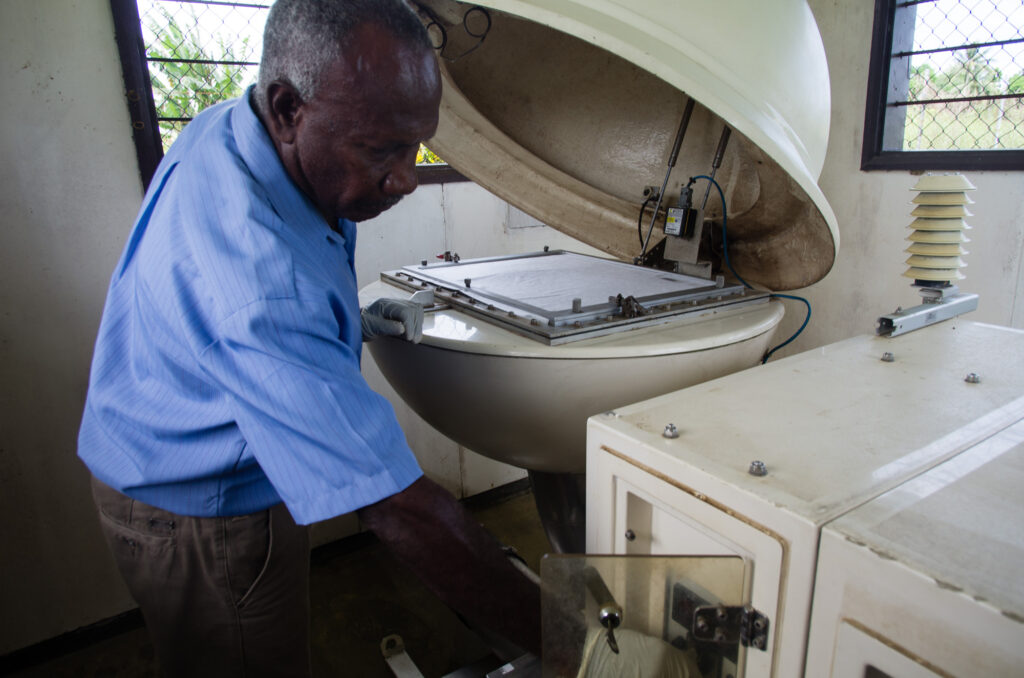
Station operator John Wiringa changing the air filter at a radionuclide station in Papua New Guinea, 2014.
Usually, the procedure is fairly routine. The team of inspectors—always at least two, sometimes more—examines equipment, takes measurements, and counts and weighs fuel containers, opening them at random to see if they hold what’s advertised. They check records to make sure they tally with what they see on site, take samples of nuclear materials and the surroundings, and ship those samples to the IAEA for analysis. As might be expected, sometimes discrepancies pop up. “Most of the time when they see something that seems out of order, it’s benign,” says Rockwood. What first seems to be missing nuclear material could simply be the result of an accounting mistake or other simple human error. Seldom will an anomaly require immediate action. Eventually a report is issued to the state noting any discrepancies that may require further investigation.
But on rare occasions a discrepancy isn’t the result of simple error or an innocent oversight. The entire point of the safeguards and on-site inspections, after all, is to ensure that nuclear material is used for peaceful purposes and not diverted for sinister purposes or passed on to another entity with less peaceful intentions. Unfortunately, Rockwood says, “verifying the absence of undeclared nuclear material and activities is a much more difficult task than verifying declared nuclear material.”
Radioactive elements are morally neutral: an atom of uranium or plutonium neither knows nor cares whether the energies of its unstable nucleus are being used inside a reactor to generate heat and ultimately produce electricity, or to tear apart other nuclei in a weapon core and so unleash the violence of a nuclear explosion. Only one isotope of uranium readily lends itself to the creation of a nuclear weapon, specifically U-235; this isotope needs to be extracted from naturally occurring uranium, which is mostly U-238. Enrichment, which separates the lighter U-235 atoms from their ever-so-slightly heavier U-238 cousins, is a laborious, atom-by-atom process and the necessary first step for anyone wanting to build a nuclear weapon. That makes it the obvious initial point at which to derail illicit nuclear ambitions.
But the same process used to produce fuel for peaceful nuclear reactors will also produce fuel for a bomb. It’s essentially a matter of degree: enrich natural uranium long enough, and you can use it in your reactor in a perfectly safe and legal way, remaining an honorable member of the international community. But enrich uranium just a bit more, to a level of about 90% U-235, and you have what’s known as “weapons-grade” fuel. (Plutonium fuel is far more difficult and expensive to create and requires a more sophisticated bomb design, making uranium the preferred option for a rudimentary nuclear weapon.)
These facts make it fairly easy for clever parties to cheat on nonproliferation agreements or to circumvent them entirely. States can hide their production of weapons-grade material behind the innocuous manufacture of peaceful reactor fuel, divert small amounts of enriched uranium for weapons programs, or completely conceal weapons-development facilities in remote areas. All of these tactics have been attempted, but just as nature has made the difference between nuclear peace and nuclear threat a matter of a few extra neutrons, it also provides the means to police that boundary.
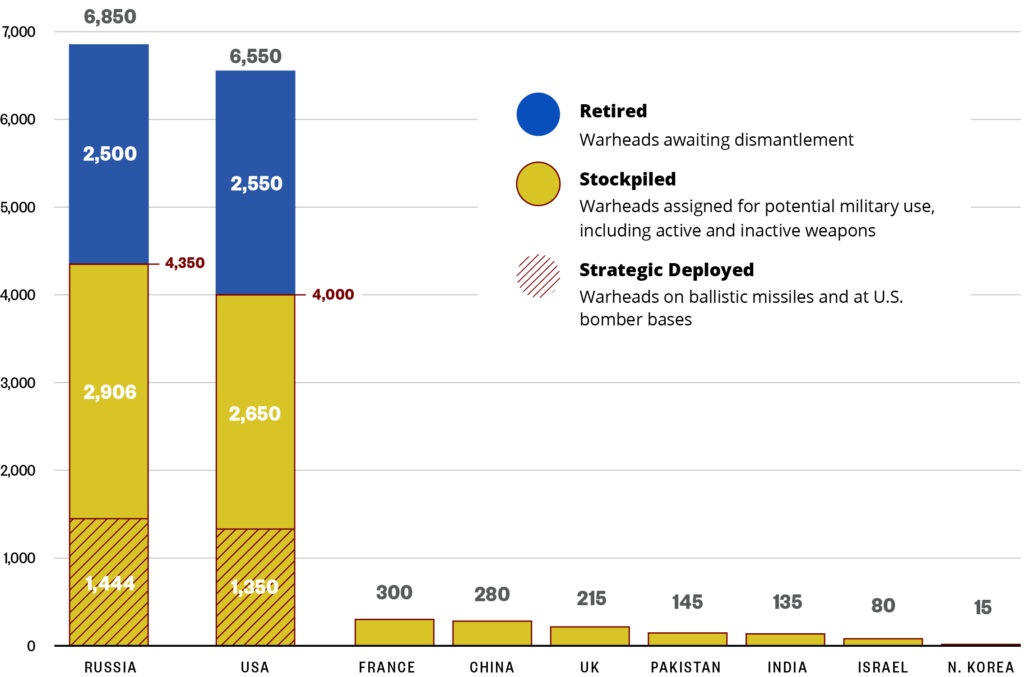
Combined, the nine nuclear-armed countries in the world possess nearly 15,000 nuclear weapons. A third of these warheads are awaiting dismantlement; the rest—more than 9,500—are deployed or stockpiled for military use. Russia and the United States control close to 90% of those weapons.
When routine inspections aren’t enough—as was the case with Iran before it signed in 2015 what’s known as the Iran nuclear deal (more formally, the Joint Comprehensive Plan of Action)—other measures beyond U.N. sanctions and diplomatic protests are possible. At this point inspectors become detectives or forensic specialists scrutinizing a crime scene for clues. That calls for measures beyond the usual record checking, container counting, radiation scanning, and facility tours.
“One of the best ways of hiding something is you take all the stuff out of the room and then you repaint the room,” says R. Scott Kemp, director of the Laboratory for Nuclear Security and Policy at MIT, describing a neat disappearing trick. “And if there were any uranium particles, for example, that were just absorbed onto the surface of the walls, they get coated with paint. And then if you come in with a swipe and you try to pick them up, you won’t get them, because they’re encapsulated in the paint.” Inspectors have responded with lasers, specifically laser-induced breakdown spectroscopy, where, says Kemp, “you take a laser, you hold it up to the paint, you blast it, it vaporizes the paint and anything else in it, and then it looks for characteristic emission lines associated with uranium and plutonium in that vapor.”
Coupled with other measures, including satellites that search for infrared signatures from power plants and good old-fashioned intelligence analysis, such techniques will sooner or later ferret out any ongoing violation. More difficult, however, is trying to determine past activities. A state might not be presently enriching uranium for bomb fuel or doing anything else untoward, but what if it had made and stored weapons-grade materials before the arrival of nosy IAEA inspectors? “There are not as yet ways of really reconstructing historical operation of declared sites,” Kemp says. “If we go into a place and they say, ‘Oh yeah, we hadn’t told you about this, here’s our enrichment plant, of course there was uranium, here it is.’ There really isn’t any available technique for determining, ‘Well, how much uranium did you produce and what’s the history of the operation?’ ”
What do you do when the nuclear “smoking gun” has long ago stopped smoking? Kemp and his MIT colleague, nuclear scientist Michael Short, are among a small group of researchers working to answer that question. While looking for a way to better quantify radiation damage in materials, Short encountered a long-forgotten idea from Manhattan Project scientist Eugene Wigner, who proposed that atoms and molecules in a material can be dislocated from their usual positions by ionizing radiation, such as X-rays and gamma rays, and that some of this energy can be stored by the atoms. Short reasoned if such stored energy, or “Wigner energy,” could be released under heat, it would produce a “fingerprint” of the defects and the specific events that caused them.

Short immediately recognized this capability would be useful in civilian nuclear applications, such as in assessing the condition of reactor vessels during periodic inspections. But he and Kemp realized it might have an even more important role. “Scott and I think we can take, say, the centrifuges in Iran, measure the stored energy, . . . figure out how many bombs they’ve made, and see if they’re lying [when they claim to have made a greater or lesser number of bombs].”
Kemp says the technique could determine both the type and amount of radiation to which something has been exposed; in other words, you can “lift these fingerprints of history from a pipe, a plastic gasket, or even the assembly table.” That would allow them to reconstruct the past operation of an enrichment plant or other nuclear facility, thus providing data that could be checked against a state’s officially declared records.
The work is still in its early stages but has already yielded promising results. The technique can show whether a material, such as stainless steel or Teflon, has been irradiated, but the crucial issue is to be able to detect precise levels of radiation over a very short time. So far, Short says, “We can detect the equivalent of about 5 or 10 years of enrichment, which is not good enough yet.” But once the process can detect recent illegal enrichment, say, 6 months ago, it will provide foolproof means for catching treaty violations. Short adds, “The preliminary results we’ve been getting are making me excited enough to think there’s something there. We’ve just got to test more samples in more controlled conditions.”
Unchecked expansion of the international nuclear-weapons club may well be a major international security problem, but the real nightmare scenario for practically any nation’s leader or for its intelligence agencies is nuclear terrorism, which requires the smuggling of radioactive material, or even a completed weapon, into a target nation. Most of the countries of the world routinely take steps to control the flow of material in and out of their borders, but preventing nuclear smuggling poses a far bigger challenge than interdicting illegal drugs or contraband—and one where the consequences of failure are potentially far more devastating.
On first consideration it might seem to be a simple matter to scan all incoming cargo for signs of radiation. But here again the practicalities of technology intrude. Particularly in a country such as the United States, with its many available points of entry by sea, air, and land, it’s impossible to inspect every container and every package on every vehicle. According to the Department of Homeland Security, about 11 million containers pass through U.S. seaports each year, with an additional 14 million entering via land borders. Major ports and points of entry do use handheld detectors, X-ray scanners, and other devices to check random cargo for suspicious radioactive and chemical signatures, but the vast majority of material passes into the United States without any such scrutiny.

Nirasha Rathnaweera of the Atomic Energy Board of Sri Lanka inspecting cargo for radiation, May 2017.
Aside from the problem of sheer volume, it’s not as easy as one might expect to find hidden nuclear material. Radiation from uranium or plutonium, especially from small amounts, can be shielded fairly easily, either by design or merely by whatever other material happens to surround it. Many perfectly innocent substances, including some common building materials and even cat litter, generate low levels of radiation that can easily mask more illicit sources. A terrorist could conceivably hide an A-bomb inside a shipping container filled with nothing but kitty litter.
All of these factors have made settling on a technological solution for nuclear security at U.S. borders a highly contentious issue, even as all involved are acutely aware of its importance. Many types of detection systems, some rather exotic, such as cosmic-ray muon imaging, have been proposed, funded by the government, and then found wanting or simply impractical when actually tested under field conditions. Some of these systems continue under development but haven’t yet been deployed.
Nuclear-detection technology comes in two basic varieties, passive and active. Passive systems, such as a Geiger counter, merely pick up traces of a radioactive material; active systems, such as an X-ray scanner, emit radiation that interacts with the target material, creating a telltale signature of radioactive contraband. Each has advantages and disadvantages, making a one-size-fits-all solution essentially impossible to achieve.
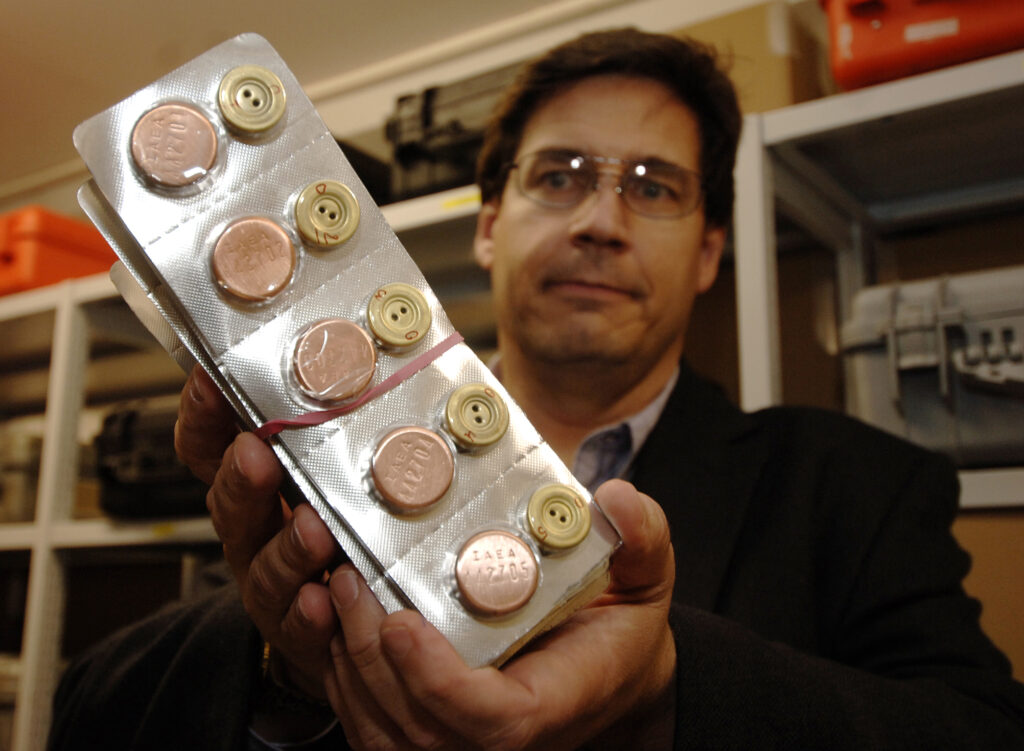
International Atomic Energy Agency inspector Mark Pellechi shows off samples of metal seals used in North Korea to indicate the unauthorized access of nuclear-related equipment and material, July 2007.
“There’s still an active debate in the field about the right way to go about this,” says Kemp. “Passive, and therefore nonintrusive and affordable, systems cannot catch shielded material and, in particular, shielded highly enriched uranium because it’s just not radioactive enough. Active systems can, but active systems threaten stowaways with lethal doses of radiation, potentially destroy electronics, and potentially activate certain isotopes. [For example], anything that has silver in it can easily be made radioactive if you’re hitting it with neutrons.” Even seemingly random factors, such as the shape of the material, can affect its detectability. “Every system has limitations,” Kemp emphasizes.
Not all those limitations are strictly technical. A detection system that may be quite reliable and accurate may still be impractical to use because of economic or other factors. A system with proven 100% accuracy wouldn’t be much use if it required every container to undergo continuous scanning for 72 hours, an impossibility in the fast-paced environment of global commerce.
Setting aside the still quite real possibility of outright nuclear war between two or more of the world’s openly declared nuclear powers, the overall prospects for keeping the atom under control aren’t entirely bleak. Real progress has been made on a variety of fronts: the continued observance of the NPT, substantial reductions in superpower arsenals since the end of the Cold War, the prevention (so far) of nuclear terrorism, the suspension (at least temporarily) of Iran’s nuclear-weapons ambitions, and even the voluntary nuclear disarmament of one nation, South Africa. Although the number of nuclear-weapons states has grown in recent decades, numbers haven’t reached the dire predictions of the past, such as John F. Kennedy’s 1960 speculation that as many as 20 nations might possess nukes by 1964. The efforts of such agencies as the IAEA and of scientists striving to develop new detection and verification technologies provide some cause for a sanguine, if not wholly optimistic, outlook.
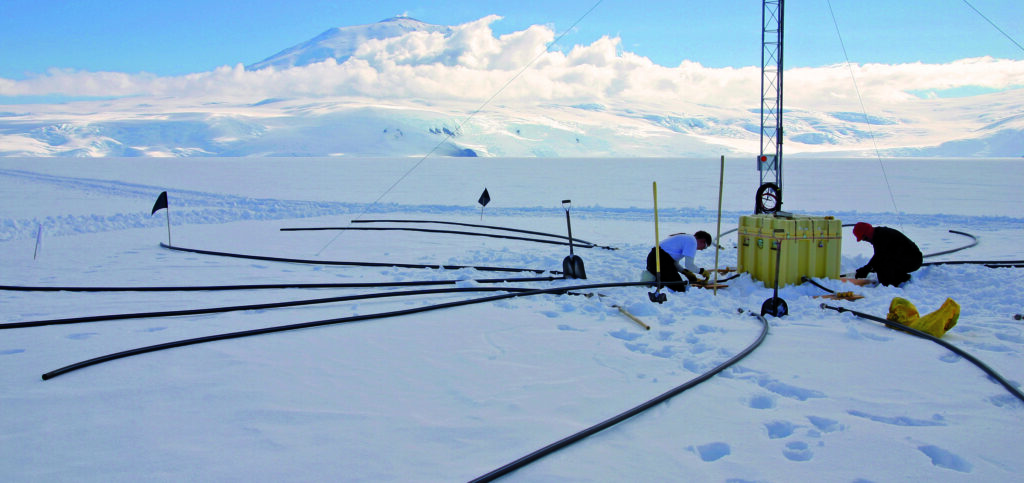
Maintenance work being done at an infrasound monitoring station in Windless Bight, Antarctica, part of the International Monitoring System, January 2007.
But much more remains to be done, and it must involve more than just a search for new technologies.
“There’s an extent to which I feel that all the gee-whiz technology that we are developing gives policymakers an excuse to not have to look at the hard politics of what is going on here,” Kemp observes. “For example, the Iran deal, as wonderful as it is in limiting Iran’s ability to make a nuclear weapon, expires in 10 years. And if you don’t use those 10 years to solve the political problems that motivate Iran’s weapons program, it has done nothing for you. It’s not an excuse to sit back. But it too often is. It removes the urgency of the issue, and therefore people just kick the can down the road.”




